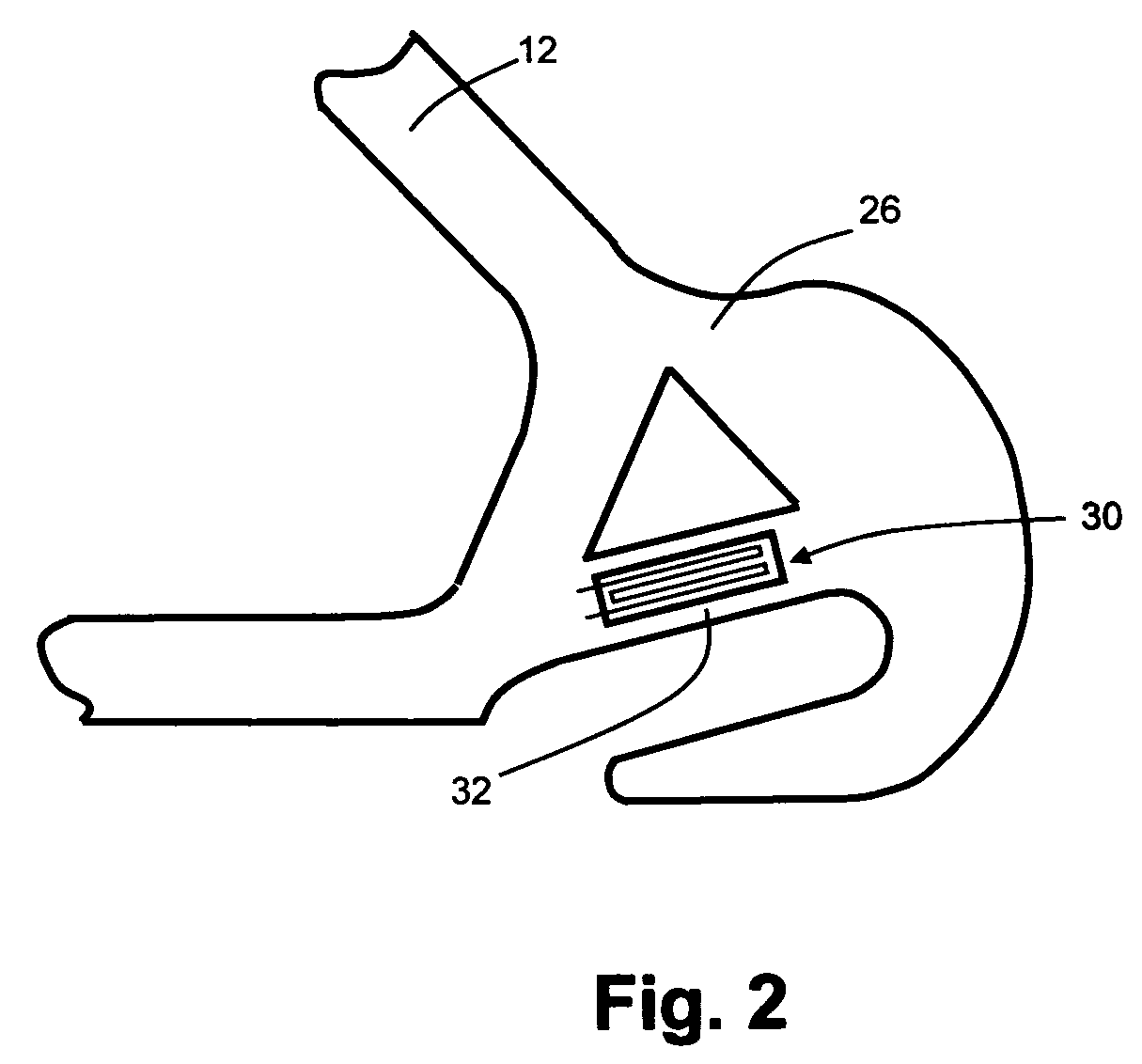Bicycle power meter with frame mounted sensor
a frame mounted sensor and power meter technology, applied in the direction of force/torque/work measurement apparatus, cycle equipment, instruments, etc., can solve the problems of not finding wide acceptance in the bicycling community, bicycle power meters using strain gauges are relatively expensive, and difficult to install, etc., to facilitate the inclusion of a bicycle power meter, easy to secure, and low cost and effort
- Summary
- Abstract
- Description
- Claims
- Application Information
AI Technical Summary
Benefits of technology
Problems solved by technology
Method used
Image
Examples
first embodiment
[0025]Turning now to the drawings, FIG. 1 is a perspective partial view taken from above of a bicycle rear frame illustrating the fork ends, hub, chain and strain gauge sensor assembly of the invention. As seen in this Fig., a bicycle rear frame has a pair of terminating portions termed a right fork 12 and a left fork 14. Secured between forks 12, 14 by means of an axle 16 and capture nuts 17, 18 are a rear hub 20 and a sprocket assembly 22. A drive chain 24 passes around individual sprockets comprising sprocket assembly 22 in order to provide rotational movement of hub 20 is response to cycling effort by the cyclist.
[0026]The end portion 26, 28 of each of forks 12, 14 has a thinner lateral thickness dimension than the remaining major portion of each fork 12, 14. Secured to the inner surface of end portion 26 of right fork 12 is a strain gauge sensor assembly 30 described more fully below. As best shown in FIG. 2, strain gauge sensor assembly 30 is attached to a thin web portion 32 ...
second embodiment
[0033]FIG. 8 is a perspective partial view taken from above of a bicycle rear frame illustrating the fork ends, hub, chain and strain gauge sensor assembly of the invention having two separate strain gauge sensor assemblies. In this Fig., elements corresponding to the same elements shown in FIG. 1 are designated with the same reference numerals, with the exception of sensor assembly 30 which is designated with reference 30a. Secured to the inner surface of end portion 28 of left fork 14 is a second strain gauge sensor assembly 30b. Sensor assembly 30b has the same structure and function as sensor assembly 30 described above. As best shown in FIG. 9, strain gauge sensor assembly 30b is attached to a thin web portion 33 extending along end portion 28 of left fork 14. Web portion 33 has the mechanical property of being relatively compressible when compared to the more robust structure of left rear fork 14, so that the physical dimensions of strain gauge sensor assembly 30b can change w...
PUM
| Property | Measurement | Unit |
|---|---|---|
| thickness | aaaaa | aaaaa |
| resistance | aaaaa | aaaaa |
| fixed resistances | aaaaa | aaaaa |
Abstract
Description
Claims
Application Information
 Login to View More
Login to View More - R&D
- Intellectual Property
- Life Sciences
- Materials
- Tech Scout
- Unparalleled Data Quality
- Higher Quality Content
- 60% Fewer Hallucinations
Browse by: Latest US Patents, China's latest patents, Technical Efficacy Thesaurus, Application Domain, Technology Topic, Popular Technical Reports.
© 2025 PatSnap. All rights reserved.Legal|Privacy policy|Modern Slavery Act Transparency Statement|Sitemap|About US| Contact US: help@patsnap.com



